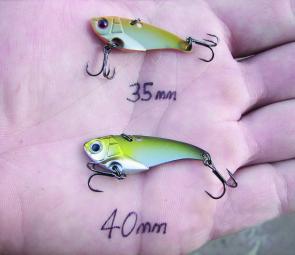Water temperatures are on the increase and South East Queensland is going to have another cracker summer season.
Unfortunately for me, I’m out of action for the next few months with a broken ankle. But at least the crabs are on the move and I don’t have to stand to retrieve my pots.
Before I did my ankle, I did get the chance to take a mate over to Mud Island to show him what’s on offer so close to home. Because he had done very little shallow fishing before, I rigged him up with an Ecogear PP60F surface popper and I fished with a small Ecogear CK50 03.
We caught lots of bream, cod and a few nice big flathead. The key to fishing the shallows on surface poppers is to cast the lure into the shallowest water and then work it towards the deeper water. Pause a few times throughout the retrieve; give the fish a chance to position the lure before engulfing it.
Surface popper fishing is very productive when targeting fish in less than 1m of water around the reef flats. Most species that inhabit the shallows will happily engulf a well presented surface offering. The most popular size of poppers are 60-110mm in length and the recommended surface walkers are between 60-90mm.
If the fish are hitting the lure and not hooking-up, then try presenting an unweighted, minnow style soft plastic in the vicinity of where the popper is getting attacked, twitch it a couple of times and hang on. This technique was successful for well known tournament anglers Carl Jocumsen and Mike Connolly in a recent bream tournament.
Presenting different follow-up baits to surface strikes is a must for serious anglers. Have a differently rigged rod when fishing surface lures to continually produce hook-ups. I’ve found when fishing surface lures, the fish don’t actually try to eat the surface offering, they instead bump it, jump over it or just miss the hooks on initial strikes.
Have an experienced angler place a different offering in the vicinity of where the surface action is happening and it is usually this follow-up bait that gets eaten. The surface lure gets the fish excited but the wafting plastic in the vicinity often gets the hook-up. This is the case for most fish that I have caught on surface lures especially barra and bream. Not a great technique for tournaments unless it’s a team event but fun for social fishing.
Snapper seem to be in good numbers around the mouth of the river throughout the entire year. The area, especially around the loading terminals has become a real hot spot for anglers fishing for the river reds. Most anglers are catching their bag limit with fish around the 2kg mark – with the occasional 4kg thrown in.
Most of the really big fish are further out in the bay, the big snapper definitely live in the river its just a matter of stopping them before they reach the pylons.
Flathead and whiting are being caught around the mouths of Bulimba Creek, Boggy Creek and the smaller drains that empty into Bramble Bay. As the tide makes, move up onto the sandy flats fish small fresh strip baits for flathead, and worms or yabbies for the big whiting.
Drift around until the fish are found before deploying the anchor. Once anchored, if the bites stop then start drifting again – most times the fish don’t stay in the same place for long periods. They move in and out with the tides, relocating to take full advantage of their available food source. As anglers, we have to continually move or present enough good burley to keep the fish in casting range.
Bream are around the island shallows, especially on the larger morning tides. Small hard-bodies and surface lures are working well for the lure anglers with fresh strip baits working best for the bait anglers. When bait fishing for bream around the shallows it is best to continually keep moving from bay-to-bay, point-to-point, flat-to-flat, to keep in contact with feeding fish.
Once a few fish are caught from a school they become bait-shy, especially during the daylight hours, so moving and presenting baits to new schools will bring the bites back on and the fish to the net.
Crabs have shown up towards the mouth of the river with some good catches of sandies and muddies. As I have said many times, fresh baits and continually moving your pots until the concentrations of crabs are found is the key to crabbing in the river.
Once the crabs are found, move all your pots in a semi circle around the area to catch the movement of the crabs. Small gutters and drains that are only visible through looking at the sounder work better than areas that have no contour changes.
I love crabbing with the family and, with my ankle being out of action for the next few months, I will be spending some time with the kids on the river checking our pots.
It’s not often that something new and exciting comes onto the market for sports fishers in Australia. Ecogear has just released its new small metal vibration range the VX series. This lure comes in two sizes, 35mm and 40mm. Small in size but very strong, the VX is worth stopping at your local tackle store to check out. Until next month…
Reads: 1381
Adam with his first surface bream – the Ecogear PP60F.

The new Ecogear VX Series 35mm and 40mm.




